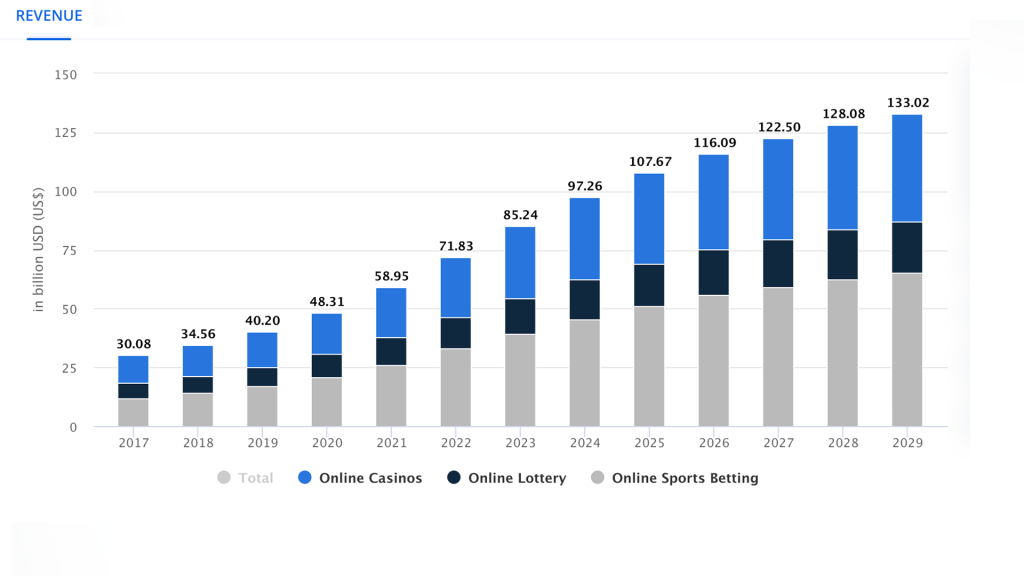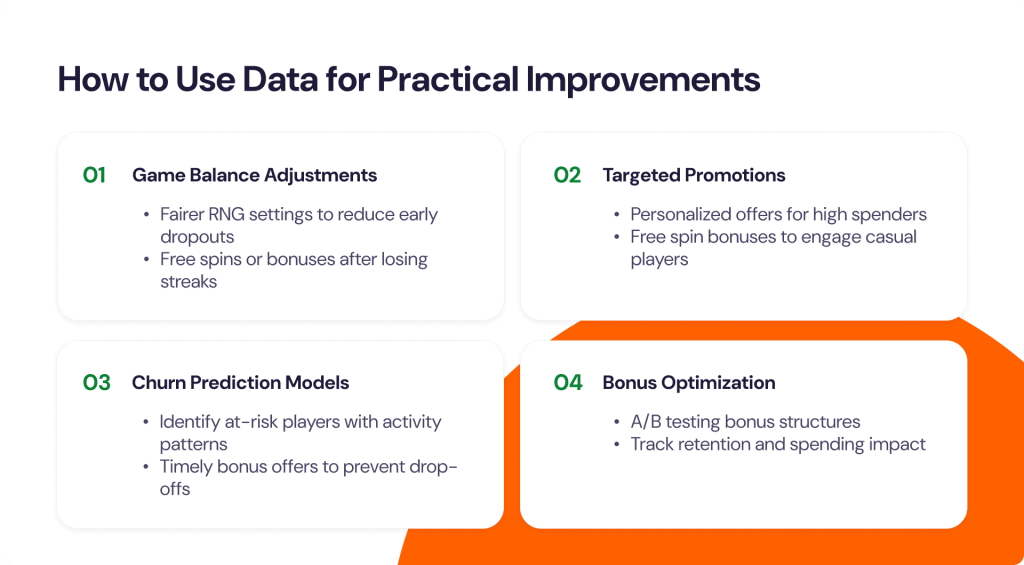The global gambling industry is booming, and the numbers back it up. According to recent data from Statista:
- Revenue is projected to hit $477.26 billion by 2025.
- Expected annual growth rate (CAGR 2025–2029) of 3.29%, pushing market volume to $543.14 billion by 2029.
- The Casinos & Casino Games segment alone is forecasted to reach $245.39 billion in 2025.
- The United States will lead globally, generating approximately $121.29 billion in revenue by 2025.
- The average revenue per user (ARPU) is projected at $498.26 in 2025, with a user base expected to hit 1 billionby 2029.
- User penetration is anticipated to be 12.3% in 2025.

In such a lucrative market, relying on intuition alone is no longer viable. Casino operators must harness the power of advanced game analytics to optimize player engagement, improve retention, and drive revenue growth.
With competition fiercer than ever, understanding and acting on player data isn’t just an advantage, it’s a necessity for staying ahead in a multi-billion-dollar industry. This guide dives into practical, data-driven strategies to help casino platforms leverage analytics for measurable business growth.
Why Are Game Analytics Crucial for Casino Platforms?
For online casino operators, understanding player behavior through analytics isn’t optional, it’s essential for long-term success. Data helps answer critical questions:
- Why are players leaving after their first session?
- Which games are driving the most revenue?
- Are the odds fair and engaging enough to keep players returning?
Using actionable insights, developers and operators can:
- Enhance player retention
- Optimize game balance
- Improve user experience
- Maximize in-game revenue opportunities
In the highly competitive online gambling market, real-time analytics can be the key to staying ahead of the competition.
If you’re looking to enhance your casino platform’s performance through data-driven insights, exploring effective casino game development solutions can provide the technical foundation needed for growth.
Key Metrics That Drive Strategic Growth
Leveraging the right data is the foundation of a successful casino platform. Beyond simple player counts, these key metrics provide the actionable intelligence needed to optimize your games, increase revenue, and ensure long-term player loyalty.
1. Player Retention Rate
What It Is: This measures the percentage of players who return to your platform after a specific period (e.g., one day, seven days).
Why It Matters: High retention is the clearest indicator of a game’s long-term value. It signifies that players are engaged, find the experience rewarding, and are invested in your platform’s ecosystem. Monitoring this metric helps you understand the health of your player lifecycle.
Actionable Insights:
- Segment your players: Analyze retention rates across different player segments (e.g., new vs. returning, high vs. low spenders) to identify which groups you are failing to engage.
- Optimize the first session: A drop in Day 1 retention may signal a poor onboarding experience or an unappealing game loop. Focus on giving new players a compelling reason to come back, such as a generous welcome bonus or a personalized challenge.
- Boost long-term loyalty: To improve Day 7 and Day 30 retention, introduce weekly challenges, loyalty programs, or seasonal promotions to keep the experience fresh and rewarding.
2. Average Session Duration
What It Is: This metric tracks how long players engage with a game during a single session.
Why It Matters: Longer session durations typically reflect higher engagement and indicate that your content is compelling. In the iGaming space, this can correlate directly with increased bet frequency and overall platform activity.
Actionable Insights:
- Refine game flow: Short session durations may point to issues with the user experience, confusing UI, or gameplay that becomes repetitive too quickly. Use analytics to pinpoint where players are dropping off.
- Introduce mid-session hooks: Extend gameplay by adding features like bonus rounds, mini-games, or progressive jackpots that encourage players to stay on the platform longer.
- Optimize performance: Ensure a smooth, fast experience. Lag, slow loading times, or crashes can drastically reduce session length.
3. Return to Player (RTP) Percentage
What It Is: RTP is the industry-standard metric that measures the percentage of all wagered money a slot or casino game is expected to pay back to players over time.
Why It Matters: This is a crucial metric for both fairness and compliance. A transparent and well-balanced RTP builds player trust and is a non-negotiable requirement for most gaming regulators.
Actionable Insights:
- Fine-tune the game math: Adjust the RTP by modifying the game’s volatility (how often and how much the game pays out) to create the desired player experience.
- Communicate clearly: Highlight the game’s RTP to players to build trust and demonstrate fairness.
4. Lifetime Value (LTV)
What It Is: LTV is a prediction of the total revenue a single player will generate throughout their entire relationship with your platform.
Why It Matters: LTV is a key business metric that informs your marketing spend, acquisition strategy, and game development priorities. It helps you understand the long-term value of your player base.
Actionable Insights:
- Identify high-value players: Analyze the characteristics and behaviors of your highest-LTV players to better target similar users.
- Personalize promotions: Use LTV data to create personalized offers and VIP programs that incentivize high-value players to remain loyal.
5. House Edge
What It Is: House Edge is the inverse of RTP—it’s the theoretical advantage the casino holds in a game over time. For example, a game with a 96% RTP has a 4% House Edge.
Why It Matters: This is a fundamental business metric. The House Edge is a guaranteed long-term profit percentage on a game. Balancing the House Edge with player engagement is critical for both business sustainability and a positive player experience.
Actionable Insights:
- Monitor profitability: Track the House Edge across your game portfolio to ensure each game is performing as expected.
- Communicate effectively: While RTP is for players, understanding House Edge is essential for your business and informs how you manage your game economy.

How to Use Data for Practical Improvements
Once you’re tracking the right metrics, the next step is using that data to make meaningful changes that enhance player experience and boost revenue. Here’s how to turn analytics into actionable strategies:
1. Game Balance Adjustments
Problem: Data shows players lose too frequently, leading to early dropouts.
Solution:
- Adjust the RNG settings to ensure fairer gameplay without compromising the house edge.
- Offer free spins or small bonuses after a string of losses to keep players engaged.
2. Targeted Promotions
Problem: Certain player segments aren’t spending as much as expected.
Solution:
- Use spending data to offer personalized bonuses to high spenders.
- Send free spin offers or small bonuses to casual players to encourage engagement.
3. Churn Prediction Models
Problem: Players leave the platform after just a few sessions.
Solution:
- Develop models that identify when players are likely to churn based on activity patterns.
- Deploy time-sensitive rewards or bonus offers right before the predicted drop-off point.
4. Bonus Optimization
Problem: Current bonuses aren’t driving enough engagement.
Solution:
- Conduct A/B tests with different bonus structures (e.g., daily rewards, welcome bonuses).
- Track which promotions yield the highest return in terms of retention and spending.
Example: How Data Transformed Player Engagement
A leading online casino platform noticed a 20% drop in engagement after just 15 minutes of gameplay. Using retention analytics, they implemented a simple strategy:
Solution: Introduce timed bonus spins at the 15-minute mark.
Results:
- Session Duration: Increased by 35%
- In-Game Purchases: Boosted by 12%
This example highlights how a small, data-driven adjustment can significantly improve both engagement and revenue.
Why Casino Platforms Should Prioritize Analytics
Integrating advanced analytics into your casino platform offers a competitive edge by:
- Enhancing player trust through fair play monitoring
- Increasing revenue through targeted promotions
- Improving user retention with real-time adjustments
- Optimizing game mechanics for a balanced, engaging experience
In a data-driven world, failing to leverage game analytics means missing out on valuable opportunities to refine player experiences and drive revenue growth.
Looking to improve your platform’s performance? Our casino game development solutions can help.
FAQ
What is game analytics in the context of casino platforms?
Game analytics refers to the process of collecting, measuring, and analyzing player data to optimize gameplay, enhance user experience, and increase revenue. It helps casino operators track player behavior, session duration, in-game purchases, and win/loss ratios to make informed decisions.
Why is game analytics important for online casinos?
Game analytics is crucial because it helps casino platforms understand player preferences, identify trends, and optimize game performance. By analyzing data, operators can improve player engagement, adjust game balance, create personalized promotions, and prevent player churn, ultimately boosting long-term profitability.
What are the key metrics used in casino game analytics?
Some of the most important metrics include player retention rate, which measures how many players return after their first session, and average session duration, which tracks how long users stay engaged in a single session. In-game purchase behavior helps identify spending trends, while win/loss ratio analysis ensures fairness and engagement by balancing player wins and losses.
How can analytics help improve player retention in online casinos?
Analytics helps operators understand why players leave and how to keep them engaged. Casinos can introduce daily rewards and loyalty bonuses to encourage repeat visits, implement timed incentives like bonus spins to extend session durations, and offer personalized promotions based on player behavior to increase long-term retention.
What is churn prediction, and how does it help casino platforms?
Churn prediction involves using data analytics to identify players at risk of leaving the platform. By analyzing player activity, casinos can proactively offer targeted bonuses, special promotions, or personalized incentives to re-engage users before they stop playing. This helps reduce player drop-offs and improve overall engagement.
How does win/loss ratio analysis impact player satisfaction?
If the win/loss ratio is too skewed, players may feel the game is unfair and stop playing. By analyzing this metric, casinos can adjust the game’s Random Number Generator (RNG) to ensure fairer gameplay while maintaining profitability. Some platforms also introduce skill-based elements to keep players engaged and in control.
How can analytics help optimize casino bonuses and promotions?
Casino operators can use A/B testing and data-driven insights to determine which bonuses drive the most engagement. By analyzing player behavior, they can adjust promotion structures, create personalized incentives for high-value players, and optimize offers to increase spending and retention.





